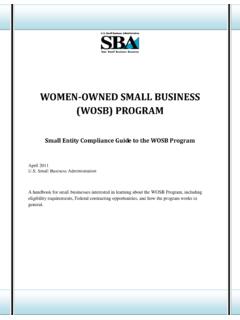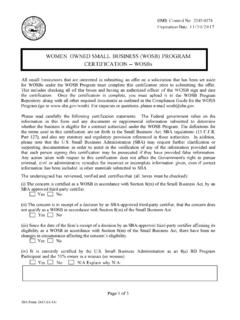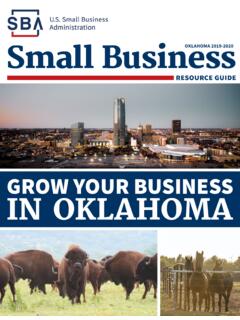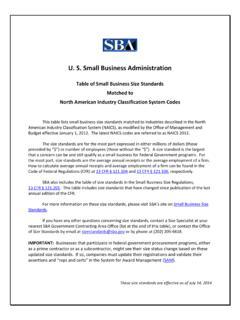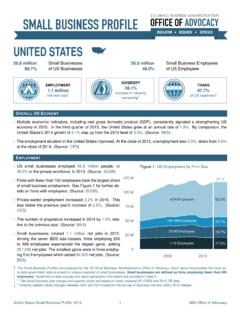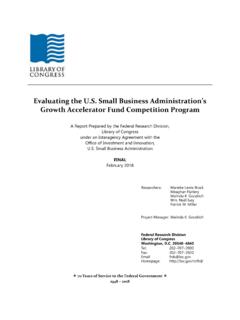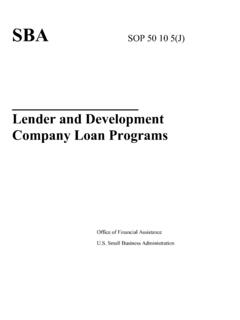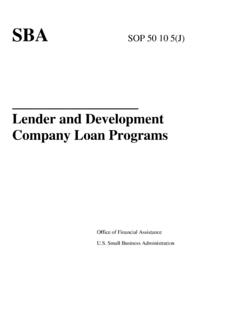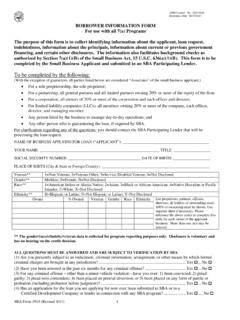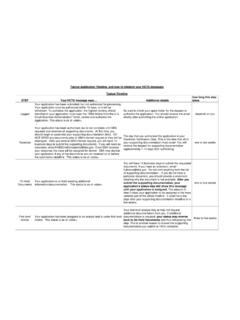Transcription of A Guide to the SBA’s Size Program and Affiliation Rules
1 1 A Guide to the SBA s Size Program and Affiliation Rules March 2014 small business Administration A handbook for small businesses and Federal officials interested in learning about the SBA s size Program . This document is published by the small business Administration pursuant to the National Defense Authorization Act of Fiscal Year 2013 (NDAA), Pub. L. 112-239, 1681(c). The NDAA requires that SBA publish this compliance Guide to assist business concerns in accurately determining their status as a small business . This Guide has no legal effect and does not create any legal rights. compliance with the procedures described in this Guide does not establish compliance with the rule or establish a presumption or inference of compliance . The legal requirements that apply are governed by SBA s size regulations, which control if there is any inconsistency between the rule and the information in this Guide .
2 2 Why is size important? In order to be eligible for certain Federal programs and certain Federal contracts and subcontracts, you must be a small business concern. SBA s size regulations, which are set forth at 13 CFR part 121, are used to determine eligibility for all SBA and Federal programs that require a concern to be small . For example, a business must be small for the following government contracting or business development programs : small business set asides; small business Innovation Research (SBIR) Program ; small business Technology Transfer (STTR) Program ; Certificate of Competency (COC) Program ; Historically Underutilized business Zone (HUBZone) Program ; women - owned small business (WOSB) and Economically Disadvantaged women - owned small business (EDWOSB) programs ; Service-Disabled Veteran- owned small business Program ; small business subcontracting; 8(a) business Development Program ; and 7(j) Management and technical assistance Program .
3 SBA s size Rules also apply to small business loan programs and grant programs . A number of government agencies, including the Food and Drug Administration and the Department of Veterans Affairs, operate programs for which small business status is a requirement for eligibility. The size Rules apply to these programs , as well. How do I know if my business qualifies as a small business concern ? To be a concern, your business entity must: (1) be organized for profit; (2) have a place of business located in the United States; and (3) make a significant contribution to the economy through the payment of taxes or use of American products, materials or labor. In general, to be considered small , concerns must meet a particular size standard that corresponds to a six-digit North American Industrial Classification System (NAICS) code. Each size standard is stated in terms of either receipts or employees, and in limited cases a basis other than receipts or employees ( , megawatt hours).
4 SBA considers the receipts or employees (or other measure) of an applicant/participant/offeror, and all of its domestic and foreign affiliates, when determining a business concern s size. For example, in order to qualify as a small business concern for a set-aside, partial set-aside, reserve, or set-aside of orders against a multiple award contract, the business must meet the size standard that corresponds to the NAICS code assigned to the solicitation and contract. 3 Example: The contracting officer assigns NAICS code 541519, Other Computer Related Services, to a solicitation. NAICS code 541519 has a size standard of $ million dollars. In order to be considered a small business for this solicitation and the resulting contract, the business would need to calculate its annual receipts over its most recently completed three fiscal years and divide by three.
5 If the business has any affiliates, it would need to add its average annual receipts with the average annual receipts of each affiliate to ensure it does not exceed the $ million size standard. If it exceeds the size standard, it is not a small business concern for purposes of this solicitation and contract. Where can I find the size standards? To help small business owners assess their small business status, SBA has established a Table of small business Size Standards which is matched to the North American Industry Classification System (NAICS) for industries. The current table of size standards is based on the 2012 NAICS. A list of the small size standards can be found at 4 business CONCERN How does SBA define the term business concern? A business concern eligible for assistance from SBA as a small business is a business entity : organized for profit, with a place of business located in the United States, and which operates primarily within the United States or which makes a significant contribution to the economy through payment of taxes or use of American products, materials or labor.
6 How does SBA define a business concern that is an agricultural cooperative? A small agricultural cooperative is an association (corporate or otherwise) acting pursuant to the provisions of the Agricultural Marketing Act (12 1141j) whose size does not exceed the size standard established by SBA for other similar agricultural small business concerns. A small agricultural cooperative's member shareholders are not considered to be affiliates of the cooperative by virtue of their membership in the cooperative. However, a business concern or cooperative that does not qualify as small under this part may not be a member of a small agricultural cooperative. Can a small business concern be a corporation, LLC or sole proprietorship? A business concern may be in the legal form of an individual proprietorship, partnership, limited liability company, corporation, joint venture, association, trust or cooperative, except that where the form is a joint venture there can be no more than 49 percent participation by foreign business entities in the joint venture.
7 How are predecessor entities treated? A firm and its predecessor entity will be treated as one business concern if a substantial portion of its assets and/or liabilities are the same. In such a case, the annual receipts and employees of the predecessor will be taken into account in determining size of the new business concern. Where can I find the regulations about the definition of business concern? They are located at 13 5 What is an affiliate ? As stated above, SBA determines whether an entity qualifies as a small business concern by counting its receipts, employees, or other measures including those of all its domestic and foreign affiliates, regardless of whether the affiliates are organized for profit. 13 (a)(6). SBA has a specific set of Rules that explain when another person, business or entity is considered an affiliate for size purposes. Where do I find SBA s Affiliation Rules ?
8 SBA s Rules on Affiliation for its programs (except SBIR and STTR) are found at 13 The regulations are available online at You may also contact any of the points of contact at the bottom of this document to receive a copy of the Rules . We note that for purposes of the SBIR and STTR Program , SBA s Affiliation regulations can be found at 13 Further information about the specific Affiliation Rules for the SBIR and STTR programs , including a compliance Guide and FAQs, is available at What are the general principles of Affiliation ? Generally, Affiliation exists when one business controls or has the power to control another or when a third party (or parties) controls or has the power to control both businesses. Control may arise through ownership, management, or other relationships or interactions between the parties. Company A Company B Company A has power to control Company B Company A and Company B are affiliates for size purposes.
9 6 Control may be affirmative or negative. Negative control includes instances where a minority shareholder has the ability, under the concern's charter, by-laws, or shareholder's agreement, to prevent a quorum or otherwise block action by the board of directors or shareholders. SBA will consider the totality of the circumstances when determining whether Affiliation exists and may find Affiliation based on the totality of the circumstances even though no single factor alone may be sufficient to constitute Affiliation . If SBA determines that Affiliation exists, then SBA will count the receipts, employees, or other measure of size for the concern whose size is at issue combined with the receipts, employees, or other measure of size for all of its domestic and foreign affiliates, regardless of whether the affiliates are organized for profit. SBA commonly receives questions about whether Affiliation exists.
10 The following is a summary of SBA s Affiliation Rules . 7 1. When may SBA find Affiliation based on stock ownership (13 (c))? Control of 50% or more of voting stock. A person1 is an affiliate of a concern if the person owns or controls, or has the power to control, 50% or more of the concern s voting stock. This is a non-rebuttable basis for finding Affiliation . Example: Company A owns Companies B, C and D ( , 81%, and 60% respectively). Company A has the power to control Companies B, C and D. The companies are all affiliated. The receipts and/or number of employees of all four companies will be aggregated in determining the size of any one of them. Control of less than 50% voting stock, but large compared to others. A person is an affiliate of a concern if the person owns and controls, or has the power to control, a block of voting stock that is large compared to all other outstanding blocks of stock even though it comprises less than 50% of the voting stock.
